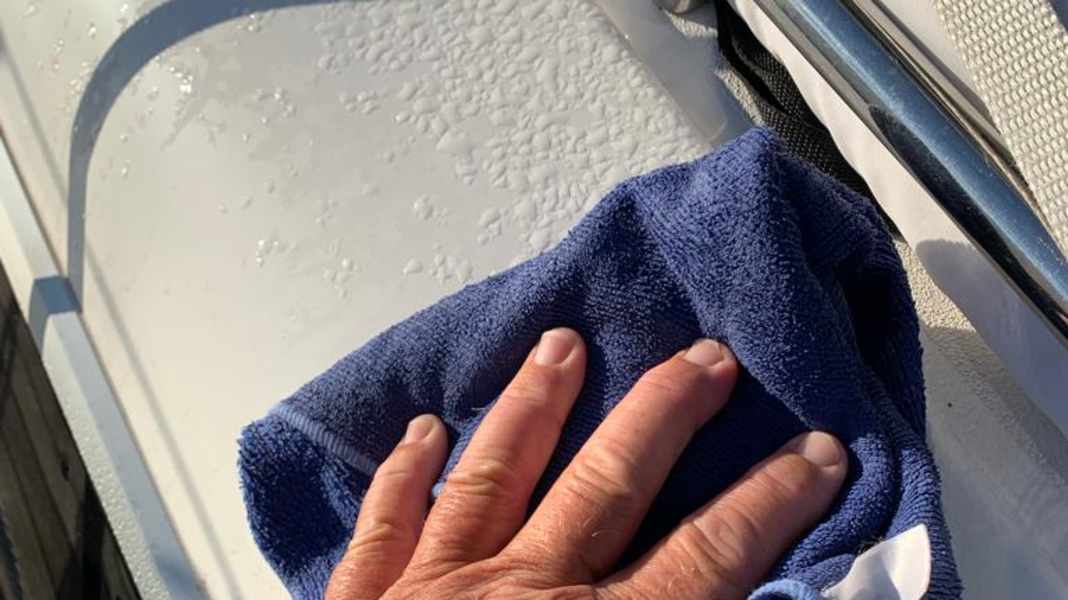
In summer and autumn, the boat deck is usually wet in the morning. The cause is morning dew. It occurs when the air cools down, especially in the very early hours of the morning, and the moisture in the air condenses. Exactly when dew forms depends on the dew point. The dew point is the temperature at which the air is saturated and water vapour condenses into liquid water. In other words, the warmer the air, the more moisture it can absorb. If it cools down, it has to release it again.
Caution with morning dew
The wet deck harbours a not inconsiderable risk of slipping. Walking barefoot over surfaces wet with morning dew, a favourite activity at anchor before a morning dip in the sea, can quickly turn into a slippery ride. Walking down and up to the jetty via the bow or stern can also be dangerous if wet surfaces are walked on without an anti-slip surface. Slip-resistant shoes should therefore be worn and special care should be taken.
If you only leave the boat quickly in the harbour, whether to go to the toilet or the bakery, you often leave unsightly footprints on the deck on your return if you walk on it in your shore shoes. The moisture loosens the dirt particles from the soles, which does not happen so easily on a dry deck.
The morning dew should therefore be removed for safety reasons alone.
Morning dew for the deck wash
Morning dew is an ideal basis for a deck wash. As the deck is already wet, no additional water from the hose is required. In addition, morning dew is lime-free, so it does not leave any unsightly marks on windows, for example. And morning dew is not salty, and the water is normally very clean, depending on the amount of dust in the atmosphere.
Another side effect is the removal of salt. If salt water was taken on deck the day before in rough seas, it does not necessarily have to be rinsed off with fresh water from the hose in the evening. Apart from the fact that this is usually not possible at anchor, the fresh water supply in the tank should not run out prematurely. The morning dew dissolves the salt and it can be removed with the dew.
Remove morning dew
A microfibre cloth is sufficient to remove the morning dew. Simply wipe up the moisture and wring out the saturated cloth regularly. The structure of the microfibre cloth has a cleaning effect, even without additional cleaning agents, so that the deck shines again afterwards.
To avoid having to constantly wring out the cloth, you can also use a squeegee like the one used in the shower at home. The squeegee lip should be made of silicone and be very long so that it can adapt to curves. The microfibre cloth then only needs to be used to remove any remaining moisture.
Seal with detailer
From time to time, the deck can also be resealed during the season using morning dew. Special detailers are available for this purpose. They are suitable for paints, gelcoats and fibreglass-reinforced plastics - water then rolls off treated surfaces and new dirt has a harder time breaking through. The detailer is simply sprayed onto surfaces that are damp from morning dew and then wiped away with water and a microfibre cloth. However, detailers are not to be confused with or equated with wax. However, the durability of a wax can be extended by using a detailer. Detailers contain a higher proportion of cleaning surfactants than waxes and are intended for quick cleaning between uses.
Handling tarpaulins
If you want to avoid getting wet in the first place, which can be particularly desirable in the cockpit, the only solution is to cover the cockpit with a sprayhood and cake stand. These are then also wet in the morning, but it is dry in the cockpit underneath. Depending on the ventilation, however, the windows may mist up on the inside. Remove the outside and, if necessary, the inside of the windows with a squeegee and remove any standing moisture from the outside of the tarpaulins using a cloth and/or squeegee. The tarpaulin then dries more quickly in the wind or sun and can be stowed away dry, which reduces the formation of mould. It is also advisable to impregnate the tarpaulins regularly, as this only leaves moisture on the fabric and prevents it from being absorbed, which speeds up the drying process.

